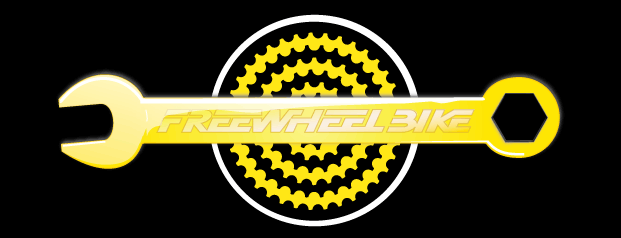Then the mountain bike revolution hit, and since mountain bikes were revolutionary, the sky was the limit for design possibilities. Frame designers were looking for problems to solve, and the market was more than willing to part with its brass for even the snake-oiliest promises of newer and better. Out of this whirlwind emerged the legendary Nishiki Alien. I was enamored upon first sight, and many of my math papers in Jr. High featured frames with elevated chain stays scrawled in the margins: my teachers probably thought it was crude occult symbolism. I was little concerned about the extra weight of several inches of surplus steel tubing required to climb up and over the drive train, and the excessive bottom bracket flex was not readily apparent from the pages of Mountain Bike Action. It just looked neat. Better than this poor thing, anyways.
The suspension boom brought a fresh crop of strangeness and wonderfulness in terms of bike design as heads collided with suspension designs to produce such masterpieces of poor function as the Cannondale SE1000, the Trek 9000, the Boulder Gazelle, or the Fisher RS1. Many manufacturers learned the hard way that a bad suspension will put you out of business faster than a clever analogy becomes a cliche.
Not everyone learned this lesson, however: an infamous example is Klein. Klein produced some of the worthiest aluminum frames that we know of: they were brutally stiff, they had great geometry, they dented like soda cans when you crashed, they came in "I'm compensating for something!!!!" colors, and they were all under three pounds. Add to this the fatigue life of their Gradient tubing: you could legitimately race a Klein for longer than it took for the drivetrain to go out of style. Aluminum bikes often crack n' fail within a few seasons of hard use due to the stresses of welding and the alignment process after heat treating, but for some reason, Kleins held up better than most. You just had to deal with the stupid rear-facing dropouts and infernal (oops, I meant internal) cable routing.
When it came to suspension bikes, Klein insisted on doing things the old fashioned way. This involved a design staff of various correspondence school graduates (with degrees in fields such as Vagrant Identification, Parapsychology, Reptile Health, and Taxi-cabmanship) and a test team of world class athletes (including two aggressive inline skaters, a cricket bowler, a swashbuckler, three fishmongers, and a fellow who could juggle bowling balls). This collaboration was responsible for the consumption of several bags of circus peanuts, the slow demise of four NES controllers, and the Klein Mantra.
While Klein loyalists, cycling journalists, and genial people everywhere tried desperately to enjoy the variable wheelbase, auto-firming suspension, and scary-things-which-happen-when-you-grab-the-brakes charm of the Mantra, the Klein office was facing some facts. About this time, a lot of things were happening: Gary Fisher had hit pay dirt with the Sugar, and Paola Pezzo had (sort of) won on it; URT bikes were being banned in many European countries; and most other Klein models had names which began with "A." Klein played it safe: they licensed the Fisher Sugar rear end; mated it to a light, stiff, candy-colored, ultra-thinwall front triangle; called it the Adept, and said "There." It was a rocket, and there was much rejoicing.
A few years later, another wave of designs was washing through the magazines, and Rock Shox founder Paul Turner emerged with the Maverick Monolink design. It was highly touted by touters of such things. Klein licensed it, called it the Palomino, and then went *POOF* into the night, to the chagrin of a lot of people. That's the shortened version.
We recently overhauled a Palomino.
 As you can see, the rear shock is structural: the rear triangle bolts to it. When your shock croaks, your bike croaks. Rear end slop plagued the stock monolink, so most responsible owners upgraded to a Maverick-branded unit which slackened the geometry a tad and floated on precision bearings instead of bushings. It was a good trade.
As you can see, the rear shock is structural: the rear triangle bolts to it. When your shock croaks, your bike croaks. Rear end slop plagued the stock monolink, so most responsible owners upgraded to a Maverick-branded unit which slackened the geometry a tad and floated on precision bearings instead of bushings. It was a good trade.
The Palomino rode much like a GT I-drive, but was simpler, lighter, and had more travel. The rearward arc of the suspension was great for seated pedaling through rough stuff, but firmed slightly when standing. It rewarded bravery if you weighted the rear wheel a bit and plowed through rough sections of trail. In the end, however, the fussy, proprietary rear shock, fragile front triangle, and availability of more efficient designs probably spelled the end of Klein's valiant suspension efforts. Trek pulled the plug on the Palomino in 2005, then Klein in general when frame stock ran out a few years later.
To the museum with you!

































